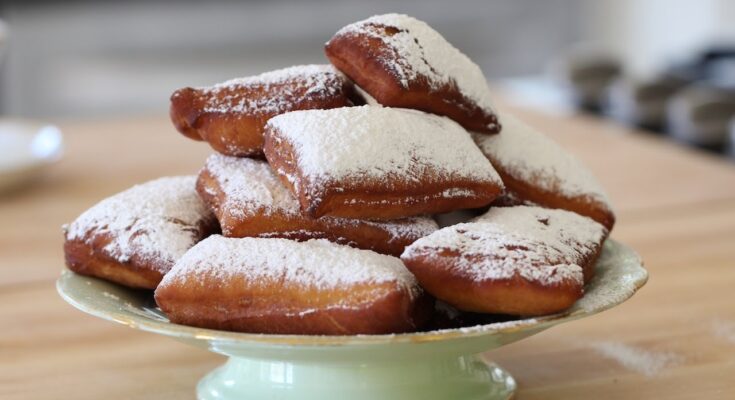Beignets Recipe: Beignets are light, airy, and fluffy fried dough pastries, often dusted generously with powdered sugar. Known for their golden-brown exterior and pillowy texture inside, these treats are a staple in New Orleans cuisine, commonly enjoyed with a cup of coffee.
Origin and History of Beignets
The word “beignet” comes from the French language, meaning “fritter” or “doughnut.” Introduced to Louisiana by French settlers in the 18th century, beignets became a cherished part of Creole culture. Today, they are famously associated with the French Quarter’s Café du Monde in New Orleans, where they are served as a signature dish.
Ingredients for Classic Beignets
Essential Ingredients
To make traditional beignets, you’ll need:
- 2 1/4 teaspoons active dry yeast
- 1 1/2 cups warm water (110°F/45°C)
- 1/2 cup granulated sugar
- 1 teaspoon salt
- 2 large eggs
- 1 cup evaporated milk
- 7 cups all-purpose flour
- 1/4 cup unsalted butter, softened
- Vegetable oil (for frying)
- Powdered sugar (for dusting)
Substitutions and Variations
- Milk Options: Use regular whole milk if evaporated milk isn’t available.
- Sweeteners: Substitute sugar with honey or maple syrup for a unique flavor twist.
- Flavored Beignets: Add vanilla or almond extract to the dough for extra aroma.
Equipment Needed
Kitchen Tools and Utensils
- Large mixing bowls
- Whisk and wooden spoon
- Rolling pin
- Sharp knife or pizza cutter
- Deep fryer or large heavy-bottomed pot
- Candy thermometer (to check oil temperature)
- Slotted spoon or tongs
- Cooling rack with paper towels
Optional Tools for Better Results
- Stand mixer with dough hook attachment for easier kneading
- Sifter for an even dusting of powdered sugar
- Pastry cutter for perfect, uniform squares
Preparing the Dough
Mixing Dry and Wet Ingredients
- Activate the Yeast: In a large bowl, dissolve the yeast in warm water. Let it sit for 5–10 minutes until foamy.
- Combine Wet Ingredients: Whisk in sugar, salt, eggs, and evaporated milk until well combined.
- Add Flour Gradually: Stir in 4 cups of flour, mixing until smooth. Add butter and gradually mix in the remaining flour until the dough forms.
Kneading and Resting the Dough
- Knead the Dough: Turn the dough onto a floured surface and knead for about 8–10 minutes until it becomes smooth and elastic.
- Resting Period: Transfer the dough to a greased bowl, cover with plastic wrap, and let it rise in a warm spot for 1–2 hours or until doubled in size.
Shaping the Beignets
Rolling and Cutting Techniques
- Prepare the Dough: Punch down the risen dough and roll it out on a floured surface to about 1/4-inch thickness.
- Cut Into Shapes: Use a sharp knife or pizza cutter to slice the dough into 2-inch squares or rectangles.
Tips for Consistent Shapes
- Uniform Sizes: Ensure all pieces are the same size for even cooking.
- Avoid Overworking: Handle the dough gently to maintain its airy texture.
Frying the Beignets
Choosing the Right Oil
Use a neutral oil like vegetable or canola oil, as it has a high smoke point and won’t overpower the flavor.
Ideal Temperature for Frying
- Heat oil in a deep fryer or pot to 360°F (182°C). Use a thermometer to monitor the temperature consistently.
- Fry 3–4 pieces at a time, cooking for about 1–2 minutes per side until golden brown.
Draining and Cooling
Avoiding Greasy Beignets
Place fried beignets on a wire rack lined with paper towels to absorb excess oil.
How Long to Cool Before Serving
Allow the beignets to cool for about 5 minutes before dusting with powdered sugar.
Dusting with Powdered Sugar
Techniques for Even Coating
- Use a sifter or fine-mesh strainer to evenly sprinkle powdered sugar over the beignets.
- Dust multiple layers for a rich, snowy appearance.
Alternative Toppings and Flavors
- Cinnamon sugar for a spicy-sweet twist.
- Drizzle with honey, chocolate, or caramel sauce for added flavor.
Serving Suggestions
Best Pairings and Dips
Beignets are often served as a breakfast or dessert, but their versatility makes them great for any occasion. Pair them with:
- Coffee or Café au Lait: The bitterness of coffee perfectly balances the sweetness of beignets.
- Hot Chocolate: Dip beignets into rich, creamy hot chocolate for a decadent treat.
- Fruit Preserves: Raspberry, strawberry, or apricot jams complement the airy texture of beignets.
- Whipped Cream or Custard: For a luxurious twist, serve with flavored whipped cream or custard.
Creative Serving Ideas
- Mini Beignets: Serve bite-sized versions for parties and gatherings.
- Stuffed Beignets: Fill them with chocolate, Nutella, or fruit compotes for extra indulgence.
- Savory Variations: Use herbs and cheese for a savory option, paired with a creamy dip.
Storage and Reheating Tips
Keeping Beignets Fresh
Beignets are best enjoyed fresh, but if you have leftovers:
- Store at Room Temperature: Place in an airtight container for up to 2 days.
- Refrigeration: Avoid refrigerating as it may cause them to lose their fluffy texture.
How to Reheat for Best Taste
- Oven Method: Preheat the oven to 350°F (175°C) and warm the beignets for 5–7 minutes.
- Air Fryer: Reheat at 350°F for 3–4 minutes to keep them crisp.
- Microwave: Use for 10–15 seconds, but this may soften the exterior.
Common Mistakes to Avoid
Troubleshooting Dough Problems
- Sticky Dough: Add more flour gradually while kneading, but avoid overdoing it to keep the dough soft.
- Dense Dough: Ensure the yeast is activated properly and the dough has had enough time to rise.
- Uneven Frying: Keep the oil temperature steady and fry in small batches.
Frying Mistakes and Solutions
- Burnt Exterior, Raw Interior: Lower the oil temperature to allow even cooking.
- Oily Beignets: Maintain the right temperature and drain excess oil immediately after frying.
- Soggy Texture: Avoid overcrowding the fryer, as it can lower the oil temperature.
Healthier Alternatives
Baking vs. Frying Beignets
For a healthier option, bake the beignets instead of frying:
- Preheat oven to 375°F (190°C).
- Place dough squares on a baking sheet lined with parchment paper.
- Bake for 12–15 minutes until golden brown.
- Brush with melted butter and sprinkle powdered sugar.
Reducing Sugar Content
- Use a light dusting of sugar or swap with cinnamon or cocoa powder for reduced sweetness.
- Substitute sugar in the dough with natural sweeteners like honey or agave syrup.
Fun Variations and Flavors
Chocolate-Filled Beignets
Add a sweet surprise by injecting melted chocolate or Nutella into the beignets using a piping bag.
Fruity and Savory Options
- Fruit-Filled Beignets: Add blueberry, raspberry, or apple fillings for fruity twists.
- Savory Beignets: Incorporate cheddar, bacon, or spinach into the dough for a savory treat.
Cultural Significance of Beignets
Beignets in New Orleans Culture
Beignets are more than just pastries in New Orleans—they’re a tradition. Café du Monde, a historic coffee shop in the French Quarter, has popularized beignets as an essential part of the city’s food culture. Often enjoyed during Mardi Gras celebrations, they symbolize indulgence and joy.
Similar Treats Around the World
- Zeppole (Italy): Italian fried dough balls, often dusted with sugar.
- Churros (Spain): Fried dough sticks served with chocolate sauce.
- Loukoumades (Greece): Honey-dipped dough puffs sprinkled with cinnamon.
- Buñuelos (Mexico): Crispy, round fritters dusted with sugar or syrup.
FAQs about Beignets Recipe
1. What are beignets?
Beignets are a French-inspired pastry famous in New Orleans, Louisiana. They are square-shaped dough pieces, deep-fried until puffy and then dusted with powdered sugar. They are often enjoyed as a breakfast treat or a dessert.
2. What ingredients are needed for a basic beignets recipe?
To make beignets, you will need all-purpose flour, sugar, salt, yeast, water, eggs, and unsalted butter. For finishing, a generous amount of powdered sugar is essential for that classic beignet look and taste.
3. How do I make the dough for beignets?
Start by dissolving yeast in warm water and then mixing it with sugar, salt, eggs, and flour. Knead until smooth and elastic, then let it rise until doubled. Once risen, roll out the dough, cut it into squares, and fry until golden brown.
4. What is the best oil for frying beignets?
Neutral oils like canola, vegetable, or peanut oil are best for frying beignets as they have a high smoke point and do not impart any additional flavors to the pastries.
5. Can beignets be made ahead of time?
Beignets are best enjoyed fresh, but you can prepare the dough ahead of time and refrigerate it overnight. Simply let the dough come to room temperature before rolling, cutting, and frying.
6. Are there any common variations of beignets?
Yes, beignets can be varied by adding fillings like chocolate, fruit jams, or cream. Some recipes also include flavorings in the dough, such as vanilla or citrus zest, to enhance the pastry’s aroma and taste.
7. How do I ensure my beignets are soft and not oily?
To ensure soft beignets, make sure your oil is at the right temperature (about 350°F) before frying. Too hot, and they’ll burn and be raw inside; too cool, and they’ll absorb oil and become greasy. Also, do not overcrowd the frying pan as it can lower the oil’s temperature.
Conclusion
Beignets are more than just a treat—they’re an experience. Whether you’re making them for a festive occasion or a cozy breakfast, following this step-by-step guide ensures light, fluffy, and perfectly golden beignets every time. With endless flavor variations and toppings, you can get creative and make this classic pastry your own. So grab your ingredients, roll out some dough, and start frying up these delightful bites of sweetness.



